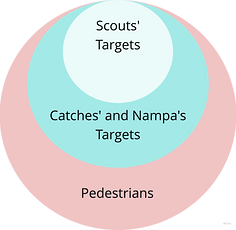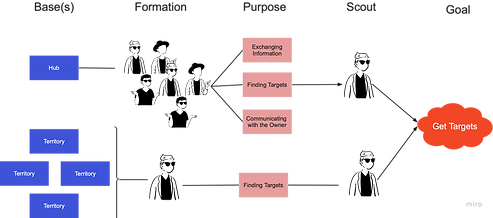
The Utilization of Space
Steps of Approaching
by Nanami
Scouts have to detect qualifications and potentials from pedestrians while the more catch and nampa approach targets, the more possibilities of success they can increase. The conditions that scouts have to take into consideration should be based on knowledge about geography and pedestrians.
1. Stationing in Hubs/Territory
Scouts are on their hubs or territories when they look for targets. Since prerequisite conditions for scouting are much narrower than targets of catch and nampa, scouts carefully scan pedestrians to find targets from them. Until they find a target, they work within hubs and multiple territories.


The difference between a hub and territories
Given the basic information of both hubs and territories, they have different purposes and sizes. On the one hand, the purpose of hubs is to exchange information with other scouts, discover targets, and communicate with the owner of hostess clubs. The hub always has several scouts; however, when approaching targets, scouts never be with companies. The territory on the other hand is for each individual scout to look for targets. In terms of the size, the hub is compact because scouts do not roam around nor have numbers of hubs to go back; however, territories are much bigger and multiple because they move between them.
The important point here is that both hubs and territories play a role to hide scouts’ identities. Taking advantage of pedestrians’ blasé attitudes toward themselves in the hubs, scouts mimic normal pedestrians. Blase attitudes refer to people being apathy and emptiness toward things while they can perceive them (Simmel, 1900).
2. Walking to targets
Once scouts find a target, they get out of their hubs or territories and walk to targets. They never wait until targets get close enough to their hubs or territories but scouts themselves get close to targets. As mentioned above, one of the reasons for having hubs and territories is to hide their identities not necessarily to approach targets. Moreover, with numerous pedestrians scrambling on the street, it is easy to ruin the chance to approach precious targets. Therefore, scouts have no chance but to chase targets and approach as soon as they find targets.
Since the conditions when scouts start to approach targets are already prepared based on scouts' knowledge, scouts can play their simulated approach. That is why their sequences to approach targets are smooth and natural.

A scout walk beside his target
3. Approaching targets
Scouts approach targets by invading targets' spaces. While scouts walk beside targets, they concisely talk or ask targets questions utilizing their tactical verbal strategies. Those one way talks are never interrupted because scouts have more information over targets.
Karp (2015) mentions
“The more information we possess about others, the more easily and correctly can we assess whether those with whom we begin a transaction will reciprocate in an acceptable fashion (p.114)”
“The difference that the social setting or context makes in an interaction is related to the amount of information it provides about the individuals taking part. Some contexts provide more information about those in them than others do (p.114)”.
What he meant by “some contexts” in the quotation are for example, scouts can predict targets’ purposes to come to Kabuki-cho according to the direction that targets come from as well as demographics from targets’ appearances. This information will help scouts to take into consideration whether targets have a qualifications to be a worker.
In addition to scouts’ more information over targets, what allows scouts to continuously talk is reinforced by calculated strategies: non-verbal and verbal communication.
4. Going back to their hubs or territories (When rejected)
In most cases, scouts fail to achieve their goal by being rejected or ignored by targets. Scouts never feel blue none the less for their failures according to their facial expressions. They rather put themselves into the mood of their next targets. They never stop nor look for targets there but promptly go back to their hubs or territories to find the next targets.
This sequence continues until they give up scouting.
Conclusion
The steps scouts have are pretty fluent and wisely calculated. While they look simple, many pedestrians cannot circumvent getting caught in scouts' traps and are turned into a target in Kabuki-cho. Seeing each step, it is obvious that scouts' actions correspond with their knowledge accumulated in advance.
*Catch is defined as people who those who are working within or with the business to lure customers into their respective stores according to Takeoka. Most of the cases, catch’s referral fee is charged in the service if going into the store (2013).
*Nampa means people who hit on a girl or ask a phone number. Nampa usually meant men.
